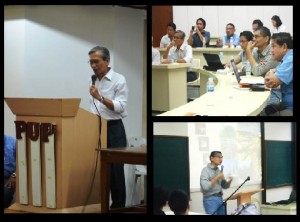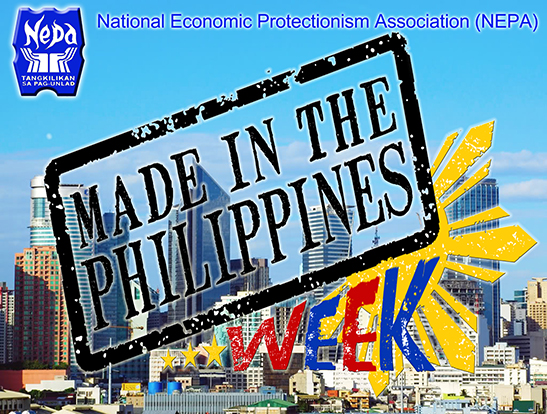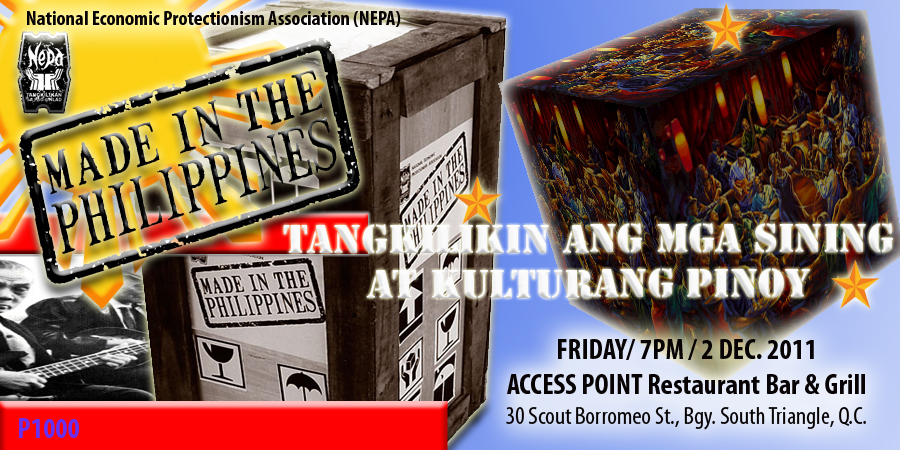NEPA FORUM
A GENERAL FRAMEWORK
ECONOMIC NATIONALISM AND NATIONAL INDUSTRIALIZATION
Economic development program without industrializing strategy has no substance.
Prosperity can never be attained without industrial development.
 by RAFAEL NELSON M. ABOGANDA
by RAFAEL NELSON M. ABOGANDA
The Philippine Economy: Basic Issues
THE REAL measure of economic development is the prosperity of the population as a whole or its direct opposite: the level of poverty! This means the optimal measure of development is the people’s living standards in terms of housing, employment/working conditions, education, health care including mother-child care, care of the elderly, and a variety of social benefits, among others. In other words, economic development is measured in terms of the country’s industrial progress supported by small and medium industries and community-based enterprises.
The Philippine government contends that the growth of gross national product (GNP) of 6.2% in 2008 and 3.0% in 2009, and gross domestic product (GDP) of 3.8% in 2008 and 0.9% in 2009 or a GDP real growth of 4.636% per year indicates that the country will still enter a new phase of economic progress based on solid economic foundations laid down by President GMA with NEDA maintaining its 2.6-3.6 percent growth target for 2010.
The Ramos administration attained 7% GNP growth, also claiming sound economic fundamentals, yet it was swiftly undermined by the crisis of 1997. Why? Simple, because of insubstantial economic policies—the solid foundation is hollow. Our economic policies lack substance that can lead to national prosperity; in fact, it has carried us to the quagmire of poverty.
The truth is very clear, the government from the presidency of Diosdado Macapagal to his daughter, Gloria Macapagal-Arroyo, has failed to improve the living standards of the ordinary Filipino due mainly to inadequate economic policies that lack the key ingredients: economic nationalism and national industrialization.
The continuing economic policies of the government, habitually predicated on the growth of GNP/GDP, with no deliberate industrializing strategies, punctuated by lack of state investments, industrial targeting and tariff protection, have generated careless development. The outcome is recurring economic crises bordering to economic stagnation. The end result is undoubtedly poverty characterized by massive unemployment, malnutrition and hunger, rising prices, decline in quality of basic education, restrictive access to health care, lack of affordable housing, chronic trade and balance-of-payments deficits, etcetera, etcetera. These are just a few of the basic issues of the Philippine economy today.
The serious policy failures include, among many others, the failed land reform, dependence on foreign debts, globalist economic programs resulting in the satellization of the economy, non-protection of local manufactures, domestic manufacturers and retailers, and most important the lack of economic nationalism and definitive industrialization program.
On the contrary, government policy-makers and business executives of the most progressive countries are one in proclaiming that only an out-and-out industrialization can create economic miracles. However, our economic planners and policy-makers never learned. No one would accept that our economic backwardness and continuing economic crisis are in many ways due to poor, insubstantial economic policies.
What we need is to assess economic development programs and industrialization efforts, if any, of the government… from Macapagal to Macapagal-Arroyo. May be, we need not do so – Ernesto Valencia, a few years ago, has offered a very general assessment, he said, “the Philippine economy has long been on a globalizing track that has increasingly opened it to the vicissitudes of international commodity and capital movements, shifted the emphasis of producers to exports, opened the domestic market to imported goods and has made the economy dependent on inflows of foreign capital both for investment and external trade financing” [emphasis supplied].
Economic Nationalism
LOOKING BACK, during a brief period of protectionism (a.k.a. “economic nationalism”) initiated in 1949, which imposed import quotas, raised tariff barriers, and instituted foreign exchange controls―these resulted in the expansion of the local manufacturing sector, which later developed into the Filipino First Policy under President Carlos P. Garcia. However, when President Diosdado Macapagal took over, he reinstituted decontrol of foreign exchange transactions and devaluation of the peso, and reverted to free trade and increased openness to foreign capital… International Monetary Fund (IMF) and World Bank entered the picture.
President Ferdinand Marcos expanded exports, primarily labor-intensive manufactures that the West needed; removed further control on foreign investments and protection of domestic industries; and relied on foreign loans and export of manpower to finance increasing budgetary and trade deficits. On the other hand, President GMA continued the structural adjustment measures of “liberalization, deregulation and privatization” in the overall context of “globalization” promoted by previous administrations of Presidents Corazon Aquino, Fidel Ramos and Joseph Estrada. Our history teaches us a very simple lesson, for our economy to grow we need economic nationalism accompanied by national industrialization.
NEPA, the oldest non-government organization in the Philippinesand Asia, must continue promoting economic nationalism, some say “new protectionism,” and national industrialization. NEPA in mid-1980s proclaimed – protectionism or economic nationalism in two simple words: “Pilipino muna!”
National Industrialization
NATIONAL INDUSTRIALIZATION is the only way to fight poverty and bring us to economic progress and prosperity!
The current economic situation
But before we move on, let us take a closer look at the current situation of the Philippine economy.
As noted earlier, the government created the current poverty situation by carrying on the four-fold economic policies of unproductive liberalization, ineffective privatization and unwieldy deregulation, anchored on indiscriminate globalist economic program in the context of free-trade, a.k.a. “globalization.”
The major elements of our national situation may be described as follows: General crisis of infrastructures—power, communications, road and transport systems; breakdown of national and social institutions—poor justice system or inequality under the law, dysfunctional bureaucracy, scalawags in military and police establishments, “cheating” in tax payments; increasing national debt—religious servicing of the swollen foreign and domestic debt resulting in high interest rates, low savings, budget deficits, continual trade and balance-of-payments deficits, extremely high cost of doing business; and the notoriously inequitable income distribution, rising prices and a weakened labor market, punctuated by failed land reform.
During the whole term of Macapagal-Arroyo, economic analysts observed that domestic industries “lost market share to competing imports made cheaper by tariff cuts and other import liberalization measures, slow growth and the continuing devaluation and deteriorating balance of payments that are the harbingers of yet another foreign exchange crisis.” They also noted that land reform policy “strongly favored the landowners, the educated, and the wealthy. Procedures such as land surveying, notice requirements, and excessive legal costs ensured that potential peasant benefactors did not gain access to land.” Other problems that led to the failed land reform are “extended land valuation process, vague guidelines for landowner compensation, extended landowner-tenant negotiations, lack of bureaucratic coordination, and inconsistent implementation.” The truth: Land reform has never been effectively implemented in thePhilippines… making our lowland farmers and upland dwellers poorer.
But government economists continue claiming that the economy is performing well amidst the following facts, earlier described: rising balance of trade/payments, increasing prices, massive unemployment, low per capita income which has not increased significantly compared to so-called GNP/GDP growth, and the stifled purchasing value of the peso.
Undoubtedly, the more recent statistics indicate that the economy is not improving in real terms. Let us probe deeper into other indicators of economic development: the country’s manufacturing sector is sluggish;
the agricultural sector is still uncompetitive; and the export growth is conspicuously slowing down. Clearly, the Philippines has a lot of catching up to do in its “development” process—now aimed at the spreading out the service industries and labeling it as “Third Wave Industrialization. Hence, more shopping malls, tourist plant facilities, etc.
For these reasons, economic nationalists of NEPA asked: “How bad does the situation have to be before the government economists admit they have failed? How bad do the economic indicators have to be to prove the erroneousness of free-market economics?”
National Industrialization: The Only Way Out of Poverty
The government has missed out the most important element that will solve current economic crises, “The development of our capacity to produce for ourselves the capital goods and intermediate goods.” NEPA keeps saying that the only way out of poverty, slow economic growth and recurrent recession is national industrialization.
In the last five decades or more, NEPA advocated that the government should put its effort to poverty alleviation and set the national economy in good order through an all-out industrialization process, the only way to create jobs. On the contrary, like her predecessors, Ms. Arroyo never seriously considered national industrialization as her development strategy.
Again and again, we at NEPA should continue advocating that national economic development can only be achieved through national industrialization, nothing else! This means encouraging the government to take the lead role in deliberately defining industrial development strategies, including state investments, import-substitution, industrial targeting and tariff protection.
Let us stop blaming our economic fiasco on some kind of regional phenomenon, an “external shock” in the clinical jargon of government economists. Let us accept that the loss of market share of domestic industries are due to competing imports made cheaper by tariff cuts and other import liberalization measures. Let us recognize that the slow economic growth and the continuing devaluation of the peso, the deteriorating balance of payments, etc. are the indicators of yet another foreign exchange crisis.
Let us prepare a true national industrialization plan not the succession of medium-term plans (MTPDPs). Long-term development plan that effectively removes import liberalization on manufacturing sector, protect our agriculture and service sectors, and promote small- and medium-industries. Let us stop relying solely on export without taking necessary steps to build our industrial base, let us develop the productive capacity of our industrial sector.
Free trade is not free! Free trade is not fair! It is controlled by the community of strong economies. We open our domestic market to foreign producers with out opening their own markets to our local producers. Let us stop our reckless import liberalization which has resulted in the loss of market share of our domestic industries.
Industrialization: A brief clarificatioin
Lastly, let us clarify what industrialization really means on the basis of the development continuum illustrated below.
Diagram 1. The Development Continuum 
This “continuum” was derived from several versions of “development continuum” proposed by different authors; among them are Colin Clark, Daniel Bell, and Alvin Toffler.
Clark contends that the growth of national economies follows three stages with dominant sectors:
1) Agricultural stage where the dominant primary sector are farming, fishing and mining.
2) Industrial stage where the dominant secondary sector are manufacturing and construction.
3) Service stage where the dominant tertiary sector is services.
Bellargued that economic development of industrialized countries passes through the following stages: agricultural stage, pre-industrial stage, industrial stage, mass consumption stage and post-industrial stage.
Toffler conceives that human civilization developed in three major revolutionary waves, these are agricultural revolution (first wave) which occurred 30,000 years ago; industrial revolution (second wave) which occurred 300 years ago; and information revolution (third wave) which began 30 years ago.
1) The first wave is characterized by the following: from nomad to settlers, food production, land/labor, seed/seedling preparation, domestication/ irrigation, property access to land and water, and the landlords.
2) The second wave civilization use energy e.g. steam engine, and at later part, fossil fuels. It features assembly line/factory system, labor vs. capital, workplace vs. home, and the capitalists.
3) Third wave civilization is characterized by handling of information using computing machines, information/labor, programmable computer, telephone/cable optic, knowledge/meta-information, networking, global village, and R&D scientists.
The development continuum illustrated above is the typical pattern of economic development that all presently developed countries have undergone, in general. It portrays the basic features of the propositions advanced by Clark,Bell, Toffler and other authors.
The development pattern was characterized by the transformation of subsistence production to agricultural production where majority of the labor force is employed in agriculture. As the national economy grows the relative importance of industry increases together with the service industry and the economy moves away from agriculture. Later, the economy shifted and develops into a fully industrialized economy.
Today, several advanced economies are entering (or have entered) the post-industrial stage variously called information-based, computer age or high-tech industrial economy. At this stage, it is expected that majority of the labor force will be employed—or are already— in the service sector characterized by a growing knowledge-based or information service industries.
As we have repeatedly pointed out above, industrialization clearly means “the development of our capacity to produce for ourselves the capital goods and intermediate goods.”



